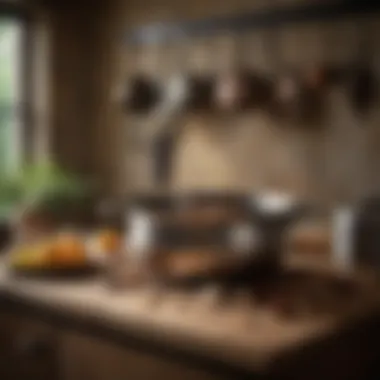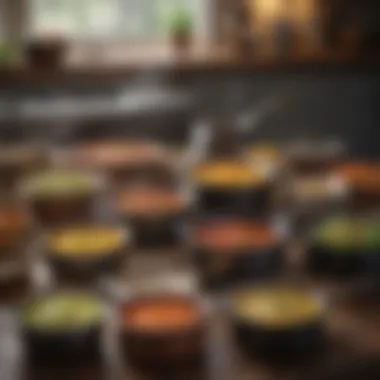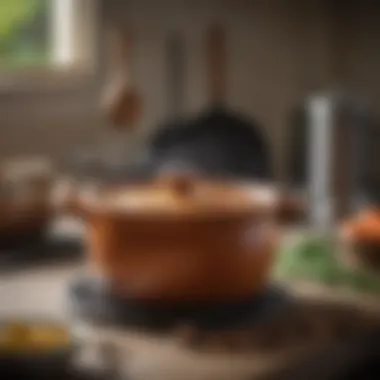Essential Pots: Unlocking Culinary Potential


Intro
Cookware plays a pivotal role in every kitchen, influencing the cooking process and the final dish. Among the various components of cookware, pots stand out as essential tools for a wide range of cooking techniques. Understanding the different types of cooking pots is crucial for anyone serious about enhancing their culinary skills. The specific material used in a pot, its size, and shape can dramatically affect even the simplest recipes.
In this article, we explore the diversity of cooking pots and the significant impact they have on culinary success. From traditional materials such as cast iron and stainless steel to modern innovations like non-stick coatings, each type of pot contributes uniquely to the cooking process. By examining the evolution of pot design and their functionality, we aim to improve not only cooking proficiency but also appreciation for these vital kitchen instruments.
Through careful selection and maintenance of cookware, home cooks can elevate their meals from mundane to extraordinary. Let's delve into this exploration of pots in the culinary world, aiming to enhance both understanding and skill in the kitchen.
Preface to Cooking Pots
Cooking pots serve as the foundation for many culinary experiences. Understanding the role and significance of these pots is essential for anyone looking to enhance their cooking skills. When one considers the vast array of techniques and meals that can be prepared, it becomes apparent that the right pot makes a critical difference in both the process and outcome of cooking.
Choosing the appropriate pot not only affects the flavor and texture of the dish but also influences cooking time and energy usage. Different types of pots serve distinct purposes, making knowledge about them invaluable. A bewildering variety of materials, shapes, and sizes exists in today’s market. This abundance complicates decision-making for cooks of all levels. However, being informed can lead to greater efficiency and creativity in the kitchen.
"The pot is often underestimated, yet it is the tool that makes flavors merge and textures come alive."
In essence, selecting the right cooking pot is a multifaceted decision that involves both practical considerations and a personal touch. Whether aiming for simplicity or sophistication, the pot you choose can profoundly influence the culinary experience. In this article, we will explore various aspects of cooking pots, aiming to inspire culinary enthusiasts to embrace the depth and variety within their kitchen.
The Importance of Choosing the Right Pot
Choosing the right cooking pot has significant implications for meal preparation and overall dining satisfaction. Different dishes require specific heat sources, cooking times, and methods. For example, simmering sauces differs in technique compared to boiling pasta or braising meats. A pot designed for one method may not yield ideal results for another. Thus, understanding each pot's characteristics is essential to making informed choices.
Furthermore, the durability and longevity of a pot must be taken into account. Quality materials can withstand high temperatures and resist warping, making them more suitable for long-term use. In addition, the aesthetics of a pot can also enhance the cooking experience, particularly when cooking for guests or family.
The pot's size is another relevant consideration. Having several sizes allows for flexibility when preparing meals for different occasions. A well-chosen pot can bring ease to your cooking process and elevate the quality of your dishes.
A Brief History of Cooking Pots
The history of cooking pots reflects the evolution of culinary practices through different cultures and eras. Originally, cooking pots were made from natural materials such as clay, which was readily available to early societies. The design and construction of these pots were rudimentary but functional, allowing for the boiling of grains and meats, a cornerstone of early human diets.
As societies progressed, so did the materials used for cooking pots. The advent of metals such as bronze and iron marked a significant development. These new materials provided better heat conductivity and durability. The transition represents not just a technological shift but also a cultural one, as food preparation became more varied with the introduction of diverse cooking methods.
Over the centuries, cooking pots have continued to evolve. They have been adapted to meet changing lifestyles and increasing culinary sophistication. Today, the selection of pots available includes advanced materials designed to improve cooking efficiency and promote health-conscious cooking.
Understanding this history enhances the appreciation of cooking pots today. The lineage of these humble tools threads through time, highlighting human ingenuity and adaptability in the kitchen. It emphasizes the importance of choosing pots that not only serve present needs but also connect to a rich culinary heritage.
Types of Cooking Pots
Understanding the various types of cooking pots is essential for achieving culinary success. Each pot has unique features and specific uses that can enhance cooking techniques. Choosing the right pot ensures efficient heat distribution, appropriate cooking methods, and therefore better food quality. This section provides detailed insights into different pots and their roles in the kitchen, allowing cooks to make informed decisions that can elevate their meals.
Stock Pots: Foundations of Culinary Stocks


Stock pots are fundamental tools in the preparation of stocks, soups, and for boiling large quantities of ingredients. Their tall and wide design allows for optimal simmering, which is essential for extracting flavors from bones, vegetables, and herbs. A good stock pot is usually made from materials that promote heat retention and distribution, such as stainless steel or aluminum. With the right stock pot, chefs can create rich, flavorful bases for various dishes. The capacity of stock pots often ranges from 8 to 20 quarts, making them perfect for recipes that serve many people or for meal prep.
Sauce Pans: Versatile Kitchen Staples
Sauce pans are among the most versatile pots in a kitchen. They are tailored for a variety of cooking methods, including simmering sauces, cooking grains, and even boiling eggs. The depth and size of a sauce pan make it suitable for tasks that require both precision and control. Generally, a sauce pan with a heavy bottom ensures even heat distribution, preventing scorching. Sizes can vary from small to medium, typically between 1 to 4 quarts. Their practicality makes them essential for both novice cooks and seasoned chefs alike.
Dutch Ovens: Slow Cooking Masters
Dutch ovens are renowned for their ability to maintain consistent heat, making them ideal for slow cooking and braising. These heavy, often cast iron pots come with a tight-fitting lid, which promotes moisture retention. The versatility of a Dutch oven allows it to transition seamlessly from stovetop to oven, accommodating various cooking techniques. From stews to casseroles, the Dutch oven is a favorite among home cooks looking for depth in flavor and tenderness in texture. It often requires seasoning to maintain its non-stick properties and durability over time.
Pressure Cookers: Modern Efficiency
Pressure cookers have transformed modern cooking by significantly reducing cooking times while maintaining food nutrition and flavor. By creating a sealed environment, pressure cookers raise the boiling point of water, leading to faster cooking processes. This efficiency is especially beneficial for tough cuts of meat and legumes, which normally take a long time to prepare. Contemporary electric pressure cookers also come with multiple settings, allowing for a range of cooking techniques from pressure cooking to slow cooking. This multitasking ability makes pressure cookers a staple for busy kitchens.
Non-Stick Pots: Convenience at Its Best
Non-stick pots provide an easy solution for those who prioritize convenience and ease of cleaning. The coating on these pots helps in minimizing food from sticking, thus requiring less oil and making for healthier cooking options. They are ideal for delicate foods such as eggs and pancakes. However, it is crucial to use non-metal utensils and avoid high heat to prolong the life of the non-stick coating. While they may not endure the same high temperatures as other materials, they serve a specific functional purpose in many cooking scenarios.
Cast Iron Pots: Timeless Cooking
Cast iron pots, often recognized for their durability and excellent heat retention, are revered for their ability to deliver consistent results in cooking. These pots can go from stovetop to oven, making them suitable for a wide variety of dishes, from frying to baking. Seasoning is vital for maintaining a cast iron pot; it helps create a natural non-stick surface while preventing rust. Over time, as cast iron develops a patina, it enhances its cooking properties. Many chefs appreciate the unique flavor cast iron can impart to the food, making it a beloved choice in culinary traditions worldwide.
Material Composition and Their Effects
Understanding the material composition of cooking pots is crucial for culinary success. The choice of material can significantly influence cooking performance, durability, and even health factors related to food preparation. Each material brings unique characteristics to the cooking process, affecting heat distribution, maintenance needs, and user experience. This section will cover the most common materials used in pots and their specific benefits and considerations.
Stainless Steel: Durability and Non-Reactivity
Stainless steel is a favored material in cookware for many reasons. It is known for its impressive durability and resistance to rust and corrosion. This makes it suitable for everyday cooking without worrying about damages. Also, stainless steel is non-reactive, meaning it won't interact with acidic or alkaline foods. This non-reactivity is important for maintaining the true flavors of various dishes.
However, one must consider that stainless steel doesn't conduct heat as effectively as some other materials. This can lead to hot spots during cooking if not designed properly. Many high-quality stainless steel pots use aluminum or copper cores to address this issue.
Copper: Conduction and Control
Copper pots are legendary for their superior heat conductivity. When it comes to temperature control, copper stands out, enabling cooks to achieve precise results. The responsive nature of copper allows for quick adjustments to cooking temperature. This property is particularly beneficial in techniques that require delicacy, such as making sauces or melting chocolate.
Nevertheless, copper does require more maintenance. It can tarnish and needs regular polishing. Moreover, it is often lined with a non-reactive material like stainless steel to prevent reactions with acidic foods. This lining mitigates health risks associated with copper exposure, though it may come at a higher cost.
Aluminum: Lightweight and Affordable
Aluminum is a popular choice for cookware due to its lightweight nature and affordability. It heats up quickly and distributes heat evenly, which can help in achieving consistent cooking results. Furthermore, aluminum pots are generally easier to handle compared to heavier materials like cast iron or stainless steel.
On the downside, aluminum is reactive with acidic foods and can affect the flavor. To address this, many aluminum pots come with anodized surfaces or coatings that prevent reactivity, making them more versatile in the kitchen. It's essential to weigh the pros and cons based on cooking needs and preferences.


Ceramic Coated: Healthy Cooking Choices
Ceramic-coated pots offer an appealing alternative in the realm of healthy cooking. These pots are non-stick, often free from harmful chemicals found in traditional non-stick coatings. This means food can be cooked with less oil, promoting healthier meal preparation. Ceramic cookware also holds well against high temperatures.
However, the coating may wear off over time, requiring careful maintenance. Avoid using metal utensils to prevent scratching the surface. Though ceramic-coated pots may not be as sturdy as other materials, their health benefits often appeal to health-conscious cooks.
"Choosing the right pot material is not just about cooking; it's about enhancing the entire culinary experience."
Functional Uses of Cooking Pots
Cooking pots serve many purposes in the kitchen, extending beyond simple boiling or simmering. Understanding the functional uses of these kitchen tools is essential for achieving culinary success. Each type of pot is designed with specific techniques in mind, which influence not only the cooking process but also the final flavor and texture of the dish. From elevating everyday recipes to executing complex culinary methods, the pot's role is integral to effective meal preparation.
Cooking Techniques and Pot Selection
Selecting the right pot for various cooking techniques is crucial. Different pots are better suited for certain methods, which can significantly affect the cooking process.
- Boiling and Simmering: A stock pot is ideal for large quantities of food, such as soups or stocks. Its tall and narrow shape allows for efficient boiling, making it perfect for pasta, for instance.
- Sauteing and Frying: A saucepan with a wide bottom and high sides is perfect for sautéing veggies and pan-frying. The larger surface area helps to achieve a good sear and evenly cook ingredients.
- Baking: Unconventionally, some pots like Dutch ovens can be used for baking bread. Their heavy lids trap steam, which promotes a crusty exterior while cooking evenly inside.
- Pressure Cooking: A pressure cooker excels with techniques requiring speed. It creates a high-pressure environment, cooking food faster while retaining moisture and flavor.
Choosing the correct pot enhances control over temperature and consistency, which are essential for successful cooking.
Pot Size and Meal Planning
Pot size is an often-overlooked element in meal planning. It affects not just the cooking experience but also how meals are portioned and served.
- Serving Size: Understanding the portion sizes your recipes yield can dictate the size of the pot needed. For a simple spaghetti meal for two, a small saucepan suffices. In contrast, a family gathering calls for larger stock pots to accommodate the increased quantity.
- Storage and Leftovers: Larger pots may facilitate bulk cooking, allowing for leftovers that can be easily stored. They are beneficial for meal prep, where many meals can be cooked at once and reheated later.
- Space Consideration: In smaller kitchens, the choice of pot should also consider storage. Compact saucepans or stackable pots can save space while offering versatility.
Maintenance and Care of Cooking Pots
The significance of maintenance and care for cooking pots cannot be overstated. Proper care can significantly extend the lifespan of your cookware, improve performance, and enhance the overall cooking experience. On the other hand, neglecting these aspects can lead to reduced efficiency, unwanted flavors in your dishes, or even damage that makes pots unusable. Every cooking pot type demands different care methods, and understanding these can help any cook succeed in their culinary pursuits.
Cleaning Techniques for Different Materials
Each material in cooking pots has unique characteristics that influence how they should be cleaned. Here are some recommended techniques:
- Stainless Steel: To clean stainless steel pots, a mixture of water and vinegar works well. This helps remove stains and maintains shine. A gentle scrub with a nylon brush will often suffice for food residue. Avoid using harsh abrasives that can scratch the surface.
- Copper: Copper pots require special attention. To remove tarnish, consider a paste made of baking soda and lemon juice. Apply it, allow it to sit briefly, and then wipe clean. Regular polishing keeps copper looking its best.
- Aluminum: Aluminum pots are more prone to scratching. To clean, use warm water and mild detergent. For tougher stains, consider using a soft sponge with a bit of baking soda. Rinse well, and dry thoroughly to prevent discoloration.
- Ceramic Coated: For ceramic coated pots, mild soap and a soft cloth are the best options. Avoid abrasive cleaners as they can scratch the coating. It's essential to handle these pots with care to maintain the integrity of the ceramic surface.
Adopting the right cleaning technique not only ensures the pots stay in good condition but also safeguards the flavors of the food cooked in them.
Seasoning and Storage of Cast Iron
Cast iron pots are known for their durability and heat retention, but they require diligent care, especially when it comes to seasoning. Seasoning helps create a natural non-stick surface and prevents rust. Here’s how to do it:
- Clean the Cast Iron: Start by washing the pot with warm water and a mild soap using a sponge. Rinse well and dry completely.
- Apply Oil: Use a paper towel to apply a thin layer of vegetable oil or flaxseed oil, covering the entire surface, both inside and out.
- Heat the Pot: Place the pot upside down in an oven preheated to 375°F (190°C). This helps the oil bond to the surface. Leave it there for one hour.
- Cool Down: Turn off the oven and let the pot cool inside.


For storage, keep cast iron pots in a dry place. Consider placing a paper towel inside the pot to absorb any moisture that might lead to rust.
Remember: Maintaining the right environment is as essential as cleaning; moisture can lead to rust, which is the enemy of cast iron cookware.
Choosing to invest time in maintaining and caring for your cooking pots, particularly those as formidable as cast iron, will yield benefits in both performance and flavor. These practices ultimately contribute to culinary success and a more enjoyable cooking experience.
Innovative Uses Beyond Traditional Cooking
In the realm of culinary practices, pots have often been perceived merely as vessels for cooking. However, their innovative uses extend far beyond traditional cooking techniques. This section aims to explore how pots can transform meal preparation and presentation. Understanding these versatile applications can enhance creativity in the kitchen, elevate meal experiences, and even contribute to plated artistry.
Embracing unique methods allows home cooks to maximize the utility of their cookware, which can lead to culinary efficiency and delightful surprises in flavors and textures. Utilizing pots in unexpected ways can change the dynamics of both cooking and serving, allowing for a more cohesive and innovative approach in the kitchen.
Using Pots for Baking and Roasting
Pots can serve various purposes, including baking and roasting, which are often overlooked. Many believe that specialized bakeware is necessary for these tasks. This is not the case.
- Dutch ovens are particularly effective for baking bread. Their heavy lids create a steam-infused environment, which results in crusty exteriors and soft interiors. Using a Dutch oven in this manner is an excellent way to make artisanal-style bread without requiring specialized equipment.
- Cast iron pots also offer versatility. The ability of cast iron to retain heat enables equally efficient roasting of meats and vegetables. The capacity to reach high temperatures allows home cooks to achieve a golden-brown, caramelized finish that is both appealing and flavor-enhancing.
The importance of temperature control and understanding pot types can further open culinary possibilities. When baking in pots, it is essential to monitor times and temperatures closely, as they often differ from traditional methods. Innovative bakers experiment with various ingredients and techniques, finding that pots can bring unique textures and flavors to baked goods and roasted dishes alike.
Creative Ways to Serve with Your Pots
Serving food directly from pots can introduce an element of rustic charm as well as practicality. Utilizing cooking pots for serving eliminates extra dishes, thereby minimizing cleanup. This concept works well in both casual and formal settings.
- Serve stews and pastas directly from a large vessel like a stock pot. This not only keeps the food warm longer but also adds flair to the dining experience. Guests can help themselves while enjoying the communal aspect of sharing a meal.
- Small sauce pans can be used for individual portions. For instance, molten chocolate cakes can be baked in small saucepans and served directly to guests, often keeping the delicious treat warm and gooey.
Repositories of heat also preserve food's warmth throughout a meal, particularly beneficial during colder months or for outdoor gatherings. Choosing the right pot for serving enhances the aesthetic and functional aspects of dining. In this textural landscape of food presentation, pots usher in a delightful amalgamation of casual dining and culinary sophistication.
"Using pots creatively can redefine culinary boundaries and evolve food culture in subtle yet impactful ways."
By harnessing the diverse capabilities of pots, home cooks can not only optimize their kitchen space but also enrich their culinary repertoire. The possibilities are vast and often only limited by one's imagination.
Ending: The Integral Role of Cooking Pots
Cooking pots are fundamental to the culinary experience. Their diverse types, materials, and functionalities make them essential tools for anyone looking to enhance their kitchen skills. The right pot can drastically improve not just the cooking process, but also the quality and taste of the food produced. Understanding the characteristics of different pots enables chefs and home cooks to select the perfect tool for each task, which ultimately contributes to culinary success.
Pots enable various cooking techniques, from simmering sauces to steaming vegetables. Additionally, the material composition affects heat distribution and cooking times. For example, copper pots allow precise temperature control, whereas stainless steel pots are durable and non-reactive. This understanding helps one navigate through countless options and find the ideal cookware.
Another significant aspect is the evolving design of cookware. Innovations have led to pots that are more efficient and user-friendly. For instance, modern non-stick surfaces reduce the need for oil while maintaining flavor, making healthy cooking accessible. Additionally, the advent of ceramic-coated pots provides a healthier alternative to traditional non-stick materials. Thus, staying informed about these innovations is crucial for quality cooking.
Final Thoughts on Pot Selection
When selecting a pot, several factors should be considered. First, assess the cooking needs. Are you making sauces, stews, or engaging in baking? Choose the pot that matches the dish. Next, consider the material: choose stainless steel for durability, copper for conduction, or non-stick for easy cleanup. Size matters as well; a larger pot might be necessary for bigger family meals.
Here are some points to remember when selecting a pot:
- Purpose: Think about the main dishes you prepare.
- Material: Choose based on cooking style and care requirements.
- Size: Align pot size with family size and meal portions.
- Maintenance: Consider how much time you can devote to care and cleaning.
Ultimately, being thoughtful in pot selection can lead to improved cooking experiences. It's about finding a balance between personal preferences and practical requirements. Understanding each aspect's weight allows food enthusiasts to make informed choices.







